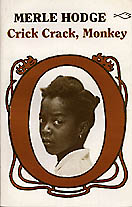Biography
Merle Hodge was born in 1944, in Curepe, Trinidad, the daughter of an immigration officer. She received both her elementary and high school education in Trinidad, and as a student of Bishop Anstey’s High School, she won the Trinidad and Tobago Girls Island Scholarship in 1962. The scholarship allowed her to attend University College, London, where she pursued studies in French. In 1965 she completed her B.A. Hons. and received a Master of Philosophy degree in 1967, the focus of which concerned the poetry of the French Guyanese writer, Leon Damas. Hodge did quite a bit of traveling after obtaining her degree, working as a typist and baby-sitter to make ends meet. She spent much time in France and Denmark but visited many other countries in both Eastern and Western Europe. After returning to Trinidad in the early 1970s, she taught French for a short time at the junior secondary level. She then received a lecturing position in the French Department at the University of the West Indies, Jamaica. At UWI she also began the pursuit of a PhD in French Caribbean Literature. In 1979 Maurice Bishop became prime minister of Grenada, and Hodge went there to work with the Bishop regime. She was appointed director of the development of curriculum, and it was her job to develop and install a socialist education program. Hodge had to leave Grenada in 1983 because of the assassination of Bishop and the resulting U.S. invasion. Hodge is currently working in Women and Development Studies at the University of the West Indies in Trinidad. She primarily participates in and facilitates creative writing workshops, and has retired from lecturing.
Themes
Works by Merle Hodge (including criticism)
- Hodge, Merle. “Beyond Negritude: The Love Poems.” Critical Perspectives on Leon Gontran Damas, ed. Keith Warner. Washington, D.C.: Three Continents, 1988.
- —. “Challenges of the Struggle for Sovereignty: Changing the World versus Writing Stories.” Caribbean Women Writers: Essays from the First International Conference, ed. Selwyn R. Cudjoe. Wellesley: Calaloux, 1990. 202-08.
- —. Crick Crack, Monkey. Andre Deutsch, 1970; London: Heinemann, 1981; Paris: Karthala, 1982 (trans. Alice Asselos-Cherdieu).
- —. ”The Folktales of Bernard Dadie.” Black Images: A Critical Quarterly on Black Arts and Culture 3:3 (1974), 57-63.
- —. For the Life of Laetitia. New York: Farrar Straus Giroux, 1993.
- —. “The Language of Earl Lovelace.” Anthurium 4.2 (2006).
- —. ”Novels on the French Caribbean Intellectual in France.” Revista Review Interamericana 6 (1976): 211-31.
- —. ”The Shadow of the Whip: A Comment on Male-Female Relations in the Caribbean.” Is Massa Day Dead? Black Moods in the Caribbean, ed. Orde Coombs. New York: Anchor Books, 1974, 111-18.
- —. ”Social Conscience or Exoticism? Two Novels from Guadalupe.” Revista Review Interamericana 4 (1974): 391-401.
- —. ”Young Women and the Development of Stable Family Life in the Caribbean.” Savacou 13 (Gemini 1977): 39-44.
Selected Works about Merle Hodge
- Balutansky, Kathleen. “We are All Activists: An Interview with Merle Hodge.” Callaloo 12:4 (Fall 1989): 651-62.
- Brown, Wayne. “Growing up in Colonial Trinidad.” Sunday Guardian (Trinidad) (June 28, 1970): 6, 17.
- Cobham, Rhonda. “Revisioning Our Kumblas: Transforming Feminist and Nationalist Agendas in Three Caribbean Women’s Texts.” Callaloo 16:1 (Winter 1993): 44- 64.
- Gikandi, Simon. “Narration in the Post-Colonial Moment: Merle Hodge’s Crick Crack Monkey.” Past the Last Post: Theorizing Post-Colonialism and Post- Modernism, ed. Ian Adam and Helen Tiffin. Hertfordshire: Harvester Wheatsheaf, 1991, 13-22.
- Harvey, Elizabeth. Review of Crick Crack Monkey. World Literature Written in English (April 1971): 87.
- Japtok, Martin.”Two Postcolonial Childhoods: Merle Hodge’s Crick Crack, Monkey and Simi Bedford’s Yoruba Girl Dancing”. Jouvert: A Journal of Postcolonial Studies, 6:1-2 (Fall 2001).
- Zonana, Joyce. ”Tee,’ ‘Cyn-Cyn,’ ‘Cynthia,’ ‘Dou-Dou’: Remembering and Forgetting the ‘True-True Name’ in Merle Hodge’s Crick Crack, Monkey“. Middle Passages and the Healing Place of History: Migration and Identity in Black Women’s Literature. Ed. Brown-Guillory, Elizabeth. Columbus, OH: Ohio State UP; 2006. pp. 139-54.
- Kemp, Yakini. “Woman and Womanchild: Bonding and Selfhood in Three West Indian Novels.” SAGE: A Scholarly Journal on Black Women 2:1 (Spring 1985): 24-27.
- Lawrence, Leota S. “Three West Indian Heroines: An Analysis.” CLA Journal 21 (December 1977): 238-50.
- Meehan, Kevin. ”Romance and Revolution: Reading Women’s Narratives of Caribbean Decolonization”. Tulsa Studies in Women’s Literature, 25: 2 (Fall 2006) 291-306.
- Thomas, Ena V. “Crick Crack Monkey: A Picaresque Perspective.” Caribbean Women Writers: Essays from the First International Conference, ed. Selwyn Cudjoe. Wellesley: Calaloux, 1990, 209-14.
- Thorpe, Marjorie. “The Problem of Cultural Identification in Crick Crack Monkey.” Savacou 13 (Gemini 1977): 31-38.
Author: Stefan Pinsky, Fall 1996
Last edited: May 2017
